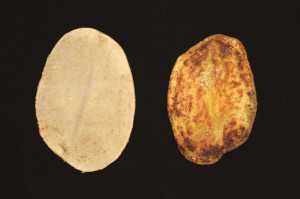USDA Scientists Dissect Zebra Chip Pest For Control Clues
In Wapato, WA, USDA Agricultural Research Service (ARS) entomologist Rodney Cooper is using fine-tipped forceps and a fluorescent microscope to dissect the organs and tissues of the potato psyllid, a tiny, cicada-like insect which can transmit the bacterium Candidatus Liberibacter solanacearum, the cause of zebra chip.

Zebra chip disease, which is vectored by the potato psyllid, causes potatoes to discolor when fried. Photo credit: Erik J. Wenninger, University of Idaho.
Cooper combines the procedure with fluorescent genetic markers to understand where and how Liberibacter survives in the psyllid, from the moment it is ingested by the insect pest to the time it is injected into new plants. The information is important on several fronts — from improved experimental designs and data interpretation to better decision-making on how best to detect, control, and prevent zebra chip, notes Cooper, who works at the ARS Fruit and Vegetable Insect Research Unit in Wapato.
Zebra chip gets its name from the dark bands it causes inside tubers. The bands are especially pronounced after the potatoes are cut and fried. Other symptoms include curled leaves and tissue discoloration. Zebra chip poses no consumer danger, but it is unsightly and can diminish tuber marketability.
After dissecting a psyllid specimen in his lab, Cooper subjects its excised organs and tissues to probes that glow green if the disease is present. Using this microscope-aided method, Cooper and his colleagues have observed Liberibacter in four main areas of the psyllid: its gut, hemolymph, bacteriomes (organs where symbiotic bacteria reside), and salivary glands.
The primary disease control method involves spraying potato crops with insecticides. However, researchers are seeking to provide growers with more sustainable approaches, particularly resistant varieties. Information from Cooper’s psyllid dissections may also eventually set the stage for targeting Liberibacter directly.
Read more about this work in the May/June 2014 issue of Agricultural Research magazine.
Source: Article by Jan Suszkiw; ARS News Service release









